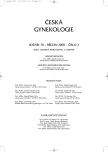The Frequency of Venous Thromboembolism in Women with F V Leiden in Association with Pregnancy and Puerperium
Authors:
P. Ďulíček 1; J. Malý 1; I. Kalousek 2; M. Beránek 3; M. Pecka 1
Authors‘ workplace:
Oddělení klinické hematologie, II. interní klinika FN, Hradec Králové, přednosta prof. MUDr. J. Malý, CSc.
1; Porodnicko-gynekologická klinika FN Hradec Králové, přednosta doc. MUDr. J. Tošner, CSc.
2; Oddělení klinické biochemie FN, Hradec Králové, přednosta prof. MUDr. V. Palička, CSc.
3
Published in:
Ceska Gynekol 2005; 70(2): 133-138
Category:
Original Article
Overview
Objective:
The assessment of the frequency of venous thromboembolism (VTE) in women with F V Leiden in association with pregnancy and puerperium and according these results and available data to formulate the principles of thromboprophylaxis.
Type of study:
Retrospective case control study.
Materials and methods:
The assessment of frequency of VTE in the group of 224 women with F V Leiden in heterozygous form in association with 460 pregnancies and in the group of 40 women with F V Leiden in homozygous form in association with 70 pregnancies. This frequency of VTE in those groups was compared with the frequency of VTE in the control group of 201 women without F V Leiden in association with 422 pregnancies. F V Leiden evaluation was done in the period of 1996–2003.
Results:
In the group of women with F V Leiden in heterozygous form VTE occurred 44-fold during pregnancy and puerperium. In l7 cases VTE was manifested in pregnancy (once in Ist trimester, twice in IInd trimester, 14 times in IIIrd trimester), in 27 women VTE occurred in puerperium and always within the first 10 days after delivery. Proximal venous thrombosis was diagnosed in 34 cases, in 5 cases being complicated by pulmonary embolism. In 10 women thrombosis was distal. The frequency of VTE is 9.6%. In the group of women with homozyous form VTE occurred in 14 cases (20%). In 5 cases VTE occurred during pregnancy, in 9 cases after delivery and in all cases within first 2 weeks after delivery. The frequency of VTE in the control group is 0.24%. The results were statistically assessed by Fisherś exact test in programme NCSS 2004. Frequency of VTE in both cohorts of women with F V Leiden reached statistical significance in comparison with the control group.
Conclusion:
Pregnancy and puerperium are significant risk factors for VTE in the group of women with F V Leiden in heterozygous form and mainly in homozygous form.
Key words:
F V Leiden, pregnancy and puerperium, venous thromboembolism, thromboprophylaxis
Labels
Paediatric gynaecology Gynaecology and obstetrics Reproduction medicineArticle was published in
Czech Gynaecology

2005 Issue 2
Most read in this issue
- Coagulation Factor VIII in the Early Postpartum Period
- Abdominal Radical Trachelectomy – Technique and Experience
- Morgagni Cyst within Tubal Lipoma
- Giant Benign Mucinous Cystadenoma of Both Ovaries in Early Puerperium: Case Report and Review of Literature
